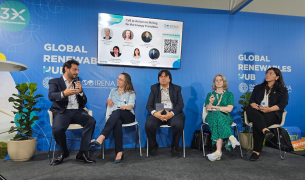Creating spaces for girls to lead

As a young female history and English teacher in Perak, Malaysia, I taught in a secondary school where gender archetypes of leadership were deeply entrenched in all spaces. Year on year, there was no question that the head prefect, sports house captains, extracurricular club presidencies, and class monitor positions would be occupied by boys—brought about by a deeply-held belief that males were inherently more suited to leadership roles. Despite clear aptitude and competence being exemplified by many girls, the highest official leadership positions they could aspire to were as deputies and secretaries, the latter because “girls were good with record keeping”. This was reflective of a broader culture of male-centric leadership in public spheres. To date, only 15% of Malaysia’s elected parliamentarians are women. In terms of school leadership, 51% of principals are male despite 70% of the teaching force being female. Beyond the transmission of traditional gender norms, a consequence of these inequitable practices was that girls would also score lower on leadership points, which factored into their post-secondary education applications. As a teacher entrusted with teaching the fifth form, Malaysia’s final year of secondary school, this was my deep concern.
Keen to explore opportunities for surfacing girls’ leadership, I began a Young History Teachers program, with eight girls and two boys applying to train as after school peer tutors for a cohort of 150 other fifth formers. The goal was twofold: to ensure that all students passed history (a compulsory subject to obtain Malaysia’s secondary school qualification) and to develop my students’ leadership acumen. In the 10 months leading up to the national examinations, each Young History Teacher planned and led creative learning activities for their group of 15 peers, coming back as a whole group to reflect on their experiences. Even during free periods, these students took ownership of their learning by commandeering the whiteboard and running pop quizzes for their friends.
The leadership of these Young History Teachers paid off. All 150 students passed their history exam at the end of the year. More importantly, the girls discovered that they could successfully lead others to achieve their goals. Three of them went on to continue demonstrating their leadership. One leads an all-female hijab sales team, another coaches patients through sports injury rehabilitation, and the third, Darshini, became a history teacher herself. A message from Darshini on Teachers’ Day thanking me for having opened her eyes to the joys of teaching will always be one of the highlights of my career as an educator.
Having seen how this simple act of creating space for girls to lead had opened their minds about the pathways available to them, I became driven to understand the enabling conditions to help girls and women achieve their limitless potential—first by participating in Teach For All’s Global Girls’ Education Fellowship, working to build the capacity of female community health volunteers to prevent noncommunicable diseases in low-resource communities, and most recently, coming onboard as Teach For All’s new Global Head of Girls’ Education to support in building our network’s knowledge on emergent best practices in girls’ education and empowerment.
The Global Context: Assessing Girls’ Opportunities to Thrive in Education
While my students’ life trajectories were altered by their experience developing their leadership, unfortunately, millions of other female students globally continue to be disenfranchised by the spectrum of sociocultural and systemic barriers preventing them from achieving their fullest potential. While 128 million girls worldwide are out of school, recent estimates project that a further 11 million girls will not be returning to school post-pandemic. In many contexts, war, conflicts, and emergencies prevent girls from attending school. Menstruation stigma, early marriages, and gendered socio-cultural expectations around domestic labour often force girls to interrupt their education. Poor infrastructure and climatic conditions affect girls’ ability to continue their education uninterrupted. Within school environments, pervasive gender attitudes also continue to exclude girls from leadership positions. Educational attainment has profound implications for girls and women’s life outcomes, such as vulnerability to gender-based violence, propensity for early marriages, intergenerational health, and labour force participation. Given these circumstances, how we collectively act will set the stage for the lived experience of future generations of girls.
The Way Forward: Collective Leadership to Accelerate Gender Equity
2022 marks a critical juncture in the fight to ensure all girls are able to access, remain in, and thrive in schools and beyond. A decade on since celebrating the first International Day of the Girl Child, we know that there is a long way to go towards building a world where girls have equal opportunities to thrive—particularly as we confront post-pandemic realities. Yet, if we work together and learn from the diversity of experiences, a gender equitable world seems within reach in our lifetime.
There is so much to be optimistic about. Across Teach For All’s global network, participants and alumni work to address a multitude of issues in girls’ education in partnership with other local stakeholders—collaborations that exemplify the kind of collective leadership necessary to ensure sustainable change. In communities across Colombia, Mariana Sanz de Santamaria, an Enseña por Colombia alumna, began Poderosas, a comprehensive sexual education (CSE) program for girls and boys to raise awareness of their sexual and reproductive health rights . By committing to centering adolescent feedback to continuously improve the program, Poderosas has reached more than 2500 adolescents to date, with presence in 19 communities across seven states, and has reduced the rates of teenage pregnancy in each of those communities.
In Afghanistan, Teach For Afghanistan fellows meet with elders and local community stakeholders in hujra (gathering places) after Friday prayers. In these spaces, fellows sit with family elders to understand their perspectives on why girls are prevented from accessing higher levels of education. Subsequently, fellows respectfully challenge these ideas by probing them on what longer term outcomes their communities may experience should there be a lack of qualified professional women such as female doctors and teachers to attend to the communities’ health or educational needs. These conversations have led to girls learning at home through the fellow-developed initiative Easy Chapters, despite continued secondary school closure to female students.
In Dang, a district in midwestern Nepal, three Teach For Nepal fellows formed a team to address common gender issues in their respective school settings, such as gender role stereotyping, menstrual health and hygiene management for girls, and sanitary practices. This collaborative effort also involved school administrators and a local holistic wellness center that were crucial in creating a safe, welcoming learning space. As a result, more girls and boys emerged equipped with the practical knowledge and transformative mindsets to navigate the physiological and social challenges of adolescence.
Through collective leadership, we can embed gender transformative practices in classrooms, communities, and environments everywhere so all girls are able to unlock their fullest potential. To do so, it is important to first build the leadership capacity of teachers and practitioners to address gender-based barriers in classrooms and communities. Recognizing the diverse contexts in which education systems function, it is also crucial to learn from, synthesise, and share insights on locally rooted best practices in girls’ education across borders, to rapidly accelerate global progress towards gender equity. Ultimately, we know that sustainable transformation can only happen when we bridge the differences across our perspectives and approaches. Therefore, equally imperative is the need to convene female students and teachers, male allies, families, communities, local leaders, policymakers, and philanthropists to reflect on their roles in closing the gender gaps in education and beyond within their respective capabilities.
For our girls, the time to act is now.
Learn more about Teach For All's Global Girls' Education Initiative.



